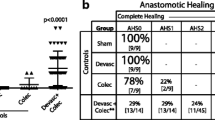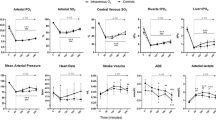PURPOSE
Acute postoperative systemic hypoxia occurs frequently in the clinical setting following intestinal resection, as a result of complications such as pneumonia, pulmonary edema, or the acute respiratory distress syndrome. Although it is well established that oxygen is essential for metabolism in general and intestinal anastomotic healing, the mechanisms by which systemic hypoxia affect this process are not clear. The purpose of this study was to establish an animal model to simulate acute systemic hypoxia and to examine the effects on anastomotic healing. We investigated the hypothesis that systemic hypoxia impairs anastomotic healing in the colon by disrupting revascularization via changes in the expression of two putative angiogenic factors: inducible nitric oxide synthase and vascular endothelial growth factor.
METHODS
Phase I: Juvenile male Sprague–Dawley rats underwent carotid artery cannulation. In a controlled environment the FiO2 was incrementally decreased from 21 to 9 percent and the resultant PaO2 measured. Phase II: Animals underwent colonic transection with immediate reanastomosis and were placed in either a normoxic (FiO2 21 percent) or hypoxic (FiO2 11 percent) environment for seven days. Perianastomotic in vivo tissue oxygen saturation was measured before segmental colon resection in each of the animals and at seven days before measurement of anastomotic bursting pressure. Perianastomotic tissue samples were assessed by Western blot assay for the expression of vascular endothelial growth factor and inducible nitric oxide synthase protein. Sections from each tissue sample were taken and evaluated by a pathologist blinded to treatment group for determination of anastomotic healing score.
RESULTS
Phase I: Incrementally decreasing the FiO2 resulted in a progressive decrease in PaO2 (r 2 = 0.77). Phase II: Animals maintained in a hypoxic environment had a significant decrease in tissue oxygen saturation (73 ± 9 percent vs. 94 ± 3 percent; P < 0.0001) and anastomotic bursting pressure (118 ± 18 mmHg vs. 207 ± 30 mmHg; P < 0.0001) compared with normoxic controls. Systemic hypoxia induced a significant increase, when compared with normoxic controls, in vascular endothelial growth factor (247.1 ± 9.5 vs. 142.2 ± 10.6; P < 0.0001) and inducible nitric oxide synthase (259.6 ± 21.1 vs. 120.2 ± 10.9; P < 0.0001) protein expression and led to a significant decrease in the overall wound-healing score.
CONCLUSION
This study validates a new animal model to study the effects of acute systemic hypoxia on colonic anastomotic healing. In this model, systemic hypoxia directly translated into local tissue hypoxia, and anastomotic healing was impaired. Contrary to our original hypothesis, hypoxia led to a significant increase in vascular endothelial growth factor and inducible nitric oxide synthase protein expression at the colonic anastomotic site. Impairment in anastomotic integrity despite upregulation of these angiogenic factors could be a result of the inability of wounded tissue to respond to vascular endothelial growth factor and inducible nitric oxide synthase or alternatively, hypoxia may adversely affect collagen synthesis and deposition directly.







Similar content being viewed by others
REFERENCES
A Vignali VW Fazio IC Lavery et al. (1997) ArticleTitleFactors associated with the occurrence of leaks in stapled rectal anastomoses: a review of 1,014 patients J Am Coll Surg 185 105–13 Occurrence Handle1:STN:280:ByiA1M%2FhtlM%3D Occurrence Handle9249076
R Golub RW Golub R Cantu SuffixJr HD Stein (1997) ArticleTitleA multivariate analysis of factors contributing to leakage of intestinal anastomoses J Am Coll Surg 184 364–72 Occurrence Handle1:STN:280:ByiB2MrjtlA%3D Occurrence Handle9100681
J Pickleman W Watson J Cunningham SG Fisher R Gamelli (1999) ArticleTitleThe failed gastrointestinal anastomosis: an inevitable catastrophe? J Am Coll Surg 188 473–82 Occurrence Handle1:STN:280:DyaK1M3kvFKmsQ%3D%3D Occurrence Handle10235574
GM Gordillo CK Sen (2003) ArticleTitleRevisting the essential role of oxygen in wound healing Am J Surg 186 259–63 Occurrence Handle1:CAS:528:DC%2BD3sXms12isbo%3D Occurrence Handle12946829
FJ Thornton A Barbul (1997) ArticleTitleHealing in the gastrointestinal tract Surg Clin North Am 77 549–73 Occurrence Handle1:STN:280:ByiA3sfjt1Q%3D Occurrence Handle9194880
AA Tandara TA Mustoe (2004) ArticleTitleOxygen in wound healing—more than a nutrient World J Surg 28 294–300 Occurrence Handle14961188
A Shandall R Lowndes HL Young (1985) ArticleTitleColonic anastomotic healing and oxygen tension Br J Surg 72 606–9 Occurrence Handle1:STN:280:BiqB1c7hs1U%3D Occurrence Handle3896373
WG Sheridan RH Lowndes HL Young (1987) ArticleTitleTissue oxygen tension as a predictor of colonic anastomotic healing Dis Colon Rectum 30 867–71 Occurrence Handle1:STN:280:BieD2MvjvFI%3D Occurrence Handle3677962
İ Hamzaoğlu T Karahasanoğlu S Aydin et al. (1998) ArticleTitleThe effects of hyperbaric oxygen on normal and ischemic colon anastomoses Am J Surg 176 458–61 Occurrence Handle9874433
H Kimura H Esumi (2003) ArticleTitleReciprocal regulation between nitric oxide and vascular endothelial growth factor in angiogenesis Acta Biochim Pol 50 49–59 Occurrence Handle1:CAS:528:DC%2BD3sXjt1Srtbg%3D Occurrence Handle12673346
L Morbidelli S Donnini M Ziche (2003) ArticleTitleRole of nitric oxide in the modulation of angiogenesis Curr Pharm Des 9 521–30 Occurrence Handle1:CAS:528:DC%2BD3sXhsVOhs74%3D Occurrence Handle12570800
A Schwentker Y Vodovotz R Weller TR Billiar (2002) ArticleTitleNitric oxide and wound repair: role of cytokines? Nitric Oxide 7 1–10 Occurrence Handle1:CAS:528:DC%2BD38XmtFSit7w%3D Occurrence Handle12175813
A Schwentker TR Billiar (2003) ArticleTitleNitric oxide and wound repair Surg Clin North Am 83 521–30 Occurrence Handle12822723
TR Howdieshell WL Webb WL Sathyanarayana PL McNeil (2003) ArticleTitleInhibition of inducible nitric oxide synthase results in reductions in wound vascular endothelial growth factor expression, granulation tissue formation, and local perfusion Surgery 133 528–37 Occurrence Handle12773981
J Li YP Zhang RS Kirsner (2003) ArticleTitleAngiogenesis in wound repair: angiogenic growth factors and the extracellular matrix Microsc Res Tech 60 107–14 Occurrence Handle1:CAS:528:DC%2BD3sXmvVSmug%3D%3D Occurrence Handle12500267
JD Hood CJ Meininger M Ziche HJ Granger (1998) ArticleTitleVEGF upregulates ecNOS message, protein, and NO production in human endothelial cells Am J Physiol 274 H1054–8 Occurrence Handle1:CAS:528:DyaK1cXitVSjs7c%3D Occurrence Handle9530221
GL Semenza (2000) ArticleTitleExpression of hypoxia-inducible factor 1: mechanisms and consequences Biochem Pharmacol 59 47–53 Occurrence Handle1:CAS:528:DC%2BD3cXhtV2htw%3D%3D Occurrence Handle10605934
SM Morris SuffixJr T Billiar (1994) ArticleTitleNew insights into the regulation of inducible nitric oxide synthesis Am J Physiol 266 E829–39 Occurrence Handle1:CAS:528:DyaK2cXltlSlsbo%3D Occurrence Handle8023911
P Braskén (1991) ArticleTitleHealing of experimental colon anastomosis Eur J Surg Suppl 566 1–51 Occurrence Handle1725603
T Hendriks WJ Mastboom (1990) ArticleTitleHealing of experimental intestinal anastomoses: parameters for repair Dis Colon Rectum 33 891–901 Occurrence Handle1:STN:280:By6D3crmtlw%3D Occurrence Handle2209281
J Biert WF Seifert AA Verhofstad et al. (1998) ArticleTitleA semiquantitative histological analysis of repair of anastomoses in the rat colon after combined preoperative irradiation and local hyperthermia Radiat Res 149 372–7 Occurrence Handle1:CAS:528:DyaK1cXit1eqs7w%3D Occurrence Handle9525502
MH Verhofstad WP Lange JA Laak Particlevan der AA Verhofstad T Hendriks (2001) ArticleTitleMicroscopic analysis of anastomotic healing in the intestine of normal and diabetic rats Dis Colon Rectum 44 423–31 Occurrence Handle1:STN:280:DC%2BD3M7pvFyqsw%3D%3D Occurrence Handle11289291
B Gelaw S Levin (2001) ArticleTitleWound-induced angiogenesis and its pharmacologic inhibition in a murine model Surgery 130 497–501 Occurrence Handle1:STN:280:DC%2BD3MrhsV2huw%3D%3D Occurrence Handle11562675
WF Seifert AA Verhofstad T Wobbes et al. (1997) ArticleTitleQuantitation of angiogenesis in healing anastomoses of the rat colon Exp Mol Pathol 64 31–40 Occurrence Handle1:CAS:528:DyaK2sXktFCksLY%3D Occurrence Handle9203507
GL Semenza F Agani N Iyer et al. (1998) ArticleTitleHypoxia-inducible factor 1: from molecular biology to cardiopulmonary physiology Chest 114 IssueID(Suppl 1) 40S–5S Occurrence Handle1:CAS:528:DyaK1cXltVSgurk%3D Occurrence Handle9676622
RG Seipelt CL Backer C Mavroudis et al. (2003) ArticleTitleTopical VEGF enhances healing of thoracic aortic anastomosis for coarctation in a rabbit model Circulation 108 IssueID(Suppl 1) III50–4
F Zhang H Lui F Stile et al. (2003) ArticleTitleEffect of vascular endothelial growth factor on rat Achilles tendon healing Plast Reconstr Surg 112 1613–9 Occurrence Handle14578792
DM Supp DT Boyce (2002) ArticleTitleOverexpression of vascular endothelial growth factor accelerates early vascularization and improves healing of genetically modified cultured skin substitutes J Burn Care Rehabil 23 10–20 Occurrence Handle11803307
C Bogdan (2001) ArticleTitleNitric oxide and the regulation of gene expression Trends Cell Biol 11 66–75 Occurrence Handle1:CAS:528:DC%2BD3MXpslyksA%3D%3D Occurrence Handle11166214
MR Schäffer U Tantry FJ Thornton A Barbul (1999) ArticleTitleInhibition of nitric oxide synthesis in wounds: pharmacology and effect on accumulation of collagen in wounds in mice Eur J Surg 165 262–7 Occurrence Handle10231662
DT Efron D Most HP Shi US Tantry A Barbul (2003) ArticleTitleModulation of growth factor and cytokine expression by nitric oxide during rat colon anastomotic healing J Gastrointest Surg 7 393–9 Occurrence Handle12654565
K Yamasaki HD Edington C McClosky et al. (1998) ArticleTitleReversal of impaired wound repair in iNOS-deficient mice by topical adenoviral-mediated iNOS gene transfer J Clin Invest 101 967–71 Occurrence Handle1:CAS:528:DyaK1cXhs1yqs7o%3D Occurrence Handle9486966
HP Shi DT Efron D Most A Barbul (2001) ArticleTitleThe role of iNOS in wound healing Surgery 130 225–9 Occurrence Handle1:STN:280:DC%2BD3MvksVeitA%3D%3D Occurrence Handle11490353
M Ziche L Morbidelli R Choudhuri et al. (1997) ArticleTitleNitric oxide synthase lies downstream from vascular endothelial growth factor-induced but not basic fibroblast growth factor-induced angiogenesis J Clin Invest 99 2625–34 Occurrence Handle1:CAS:528:DyaK2sXjs1Knurs%3D Occurrence Handle9169492
PC Lee N Salyapongse GA Bragdon et al. (1999) ArticleTitleImpaired wound healing and angiogenesis in eNOS-deficient mice Am J Physiol 277 H1600–8 Occurrence Handle1:CAS:528:DyaK1MXntF2hu7g%3D Occurrence Handle10516200
T Murohara T Asahara M Silver et al. (1998) ArticleTitleNitric oxide synthase modulates angiogenesis in response to tissue ischemia J Clin Invest 101 2567–78 Occurrence Handle1:CAS:528:DyaK1cXjvVahs7w%3D Occurrence Handle9616228
RS Smith KF Lin J Agata L Chao J Chao (2002) ArticleTitleHuman endothelial nitric oxide synthase gene delivery promotes angiogenesis in a rat model of hindlimb ischemia Arterioscler Thromb Vasc Biol 22 1279–85 Occurrence Handle1:CAS:528:DC%2BD38Xmt12jurk%3D Occurrence Handle12171788
K Jonsson JA Jensen WH Goodson et al. (1991) ArticleTitleTissue oxygenation, anemia, and perfusion in relation to wound healing in surgical patients Ann Surg 214 605–13 Occurrence Handle1:STN:280:By2D287is1E%3D Occurrence Handle1953114
MC Robson DL Steed MG Franz (2001) ArticleTitleWound healing: biologic features and approaches to maximize healing trajectories Curr Prob Surg 38 72–141 Occurrence Handle1:STN:280:DC%2BD38%2Fit1KrtA%3D%3D
MB Witte A Barbul (1997) ArticleTitleGeneral principles of wound healing Surg Clin North Am 77 509–28 Occurrence Handle1:STN:280:ByiA3sfjtFw%3D Occurrence Handle9194878
H Oxlund H Christensen M Seyer-Hansen TT Andreassen (1996) ArticleTitleCollagen deposition and mechanical strength of colon anastomoses and skin incisional wounds of rats J Surg Res 66 25–30 Occurrence Handle1:CAS:528:DyaK2sXks12gtQ%3D%3D Occurrence Handle8954827
H Jiborn J Ahonen B Zederfeldt (1978) ArticleTitleHealing of experimental colonic anastomoses I. Bursting strength of the colon after left colon resection and anastomosis Am J Surg 136 587–94 Occurrence Handle1:STN:280:CSaD3sbnt1Y%3D Occurrence Handle360857
MJ Koruda RH Rolandelli (1990) ArticleTitleExperimental studies on the healing of colonic anastomoses J Surg Res 40 504–15
ACKNOWLEDGMENTS
The authors thank Dr. John Kolb, from the Faculty of Kinesiology, and the Human Performance Research Group for providing the hypoxia generator which allowed this project to occur; the Cardiovascular Research Group, especially Dr. J. V. Tyberg, for the use of their blood gas analyzer; and Gail Wright-Wilson and Laurie Wallace for their assistance.
Author information
Authors and Affiliations
Corresponding author
Additional information
Supported by Alberta Children’s Hospital Research Foundation.
Reprint requests to: David L. Sigalet, M.D., Ph.D., FRCSC, Department of Surgery, Room 1746, Health Sciences Centre, 3330 Hospital Drive NW, Calgary, Alberta, Canada T2N 2T9.
About this article
Cite this article
Attard, JA., Raval, M., Martin, G. et al. The Effects of Systemic Hypoxia on Colon Anastomotic Healing: An Animal Model. Dis Colon Rectum 48, 1460–1470 (2005). https://doi.org/10.1007/s10350-005-0047-3
Published:
Issue Date:
DOI: https://doi.org/10.1007/s10350-005-0047-3




